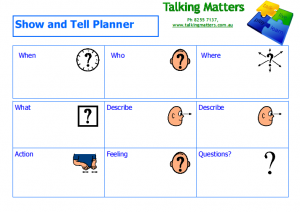Help your child shine at "show and tell" time.
Show and tell” or “news time” is a regular part of the school routine and a valuable opportunity to develop language skills but it can be a difficult task for children with speech, language, learning or social difficulties and can result in anxiety for children with low confidence. There are however things that can be done to support your child both at home and at school to make it a more enjoyable and educational experience.
Each teacher has a different way of running their show and tell sessions. If you are not familiar with how sessions are run in your child’s class discuss it with the teacher. Some questions to ask include:
When is your child expected to do show and tell? Some classes have a set timetable, in others students choose to speak when they wish to. If there is a timetable make sure you know when your child’s time is so you can help them prepare. If the child is able to choose ask the teacher how often would be reasonable for your child to speak. If your child prepares something make sure the teacher knows so they can ensure your child has a chance to speak.
Is there a set topic? If there a list of topics ask for a copy, or for the topic to be put in your child’s diary or communication book ahead of time so you can help your child plan ahead. If children choose their own topics ask what types of topics the other children often choose. This will help your child choose something that interests the rest of the class.
How long is each child expected to speak for? If the expected time is unrealistic for your child’s abilities discuss with the teacher what might be reasonable for your child to be expected to do.
Is it a whole class activity? Some classes speak in small groups, others address the whole class at once.
Do the other children ask questions? If so how many and what type of questions do they typically ask? Is the teacher happy for you to prepare for some questions that can then be asked by some supportive children.
Are there any other rules or things you need to know? Some teachers have rules around “no toys” or other topics that children are not permitted to discuss during show and tell.
Once you have a clear idea what is expected you can more effectively prepare your child. Help your child to prepare for show and tell by:
Preparing for the topic. Choose a suitable topic that your child is interested in and will feel confident and comfortable discussing. Help your child research the topic. Gather some hands on resources.
Planning the presentation. Work out with your child what they want to say and how they will say it.
Practice the presentation. Be your child’s audience and watch and listen as they present. The more times they can practice the more confident they will be. Make it as much like the way your child will do it at school as possible. Sit your child on a chair and sit yourself on the floor. Put your hand up and allow your child to ask you for a question. If there are specific greetings used practice these too.
Some other things to try include:
Use visual supports: These might be a real object to talk about, some photos of your child if they are talking about an outing or activity they have done, some pictures that your child has drawn about the topic or that you have printed from the internet.
Use a planner to plan out what your child is going to say: This is like a story map and you can use it to help your child plan what they will say. You can use pictures for children who can’t read. You can download a planner here. .
Once you have planned it on the planner, help your child use the plan to practice presenting and then take it to school to help them do the real thing.
Use your child’s communication book to support the teacher. If your child has limited communication skills or their speech is difficult to understand, write in your child’s communication book what your child’s topic is and some background information. This might include who gave them the item, where they got it, where they went and what they did there. If your child will need to answer questions include answers to the questions kids might commonly ask. This will help the teacher understand your child’s presentation and the teacher can then help supportive children ask suitable questions and fill in any unknown information that your child is not able to provide.
Try an alternative method of presenting. If your child has very limited communication skills or is very shy discuss with the teacher whether they could present in a different way such as through a power point or slide show display, or a short video they could record at home.
Use a social story to help your child prepare for show and tell. Social stories prepare your child for what will happen and help them to know in advance what they have to do, reducing anxiety and increasing the chances of success. For more information about social stories visit http://www.thegraycenter.org/social-stories/how-to-write-social-stories
Help your child be involved in other children’s presentations. If your child has very limited communication skills help them to ask questions of other children by practising questions in advance. You could also write some questions on a card, using pictures or symbols if your child needs them and sending them to school with your child. During show and tell your child could use the card as a cue to ask a question or raise their hand and give the card to the teacher or another child to ask. Children with communication devices could have some common questions programmed into their device so they could ask them. Make sure you discuss these options with your child’s teacher so your child can be supported in their efforts.
We hope show and tell becomes a valued way to develop your child’s communication and confidence.
Related Blog Posts
If you liked this post you may also like:
Beginning questions
Why use PECS?
Action sentences
FAQ Speech pathology



